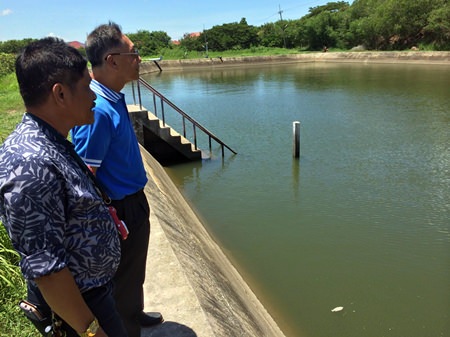
Officials inspect
Sattahip’s water supply for contaminants following an outbreak of
stomach illnesses late last month.
Patcharapol Panrak
Sattahip officials are investigating the cause of suspected
water contamination believed responsible for sending at least 600
residents to the hospital with stomach ailments.
District Water Supply Department officials on Sept. 7 tested the area’s
water-storage tank to determine if it was contaminated with chemicals or
some other agent that also caused resident fish to die. While
authorities were still waiting for test results, they ruled out that the
dead fish themselves were cause of the ailments, as fish typically can
be found in hard-water storage tanks and thrive there.
However, many of the fish died, probably due to a lack of oxygen in the
tank. Officials ordered the dead fish removed, put in plastic bags with
alum and then disposed of at a local dump.
Around the same time, in late August, 610 Sattahip residents poured into
Queen Sirikit Naval Medical Center, Apakorn Kiatwong Hospital and
Sattahip Hospital, complaining of stomach aches and vomiting. Affected
were 163 teachers and students from Sattahip Navy School, 83 from the
Singhsamut School, 37 from Sattahip High School, 44 from Lerdpannya
School, 52 from Ban Sattahip School, 48 from Navikyoburana School, and
49 from Sattahip Naval Fleet School. Another 183 area residents also
went to the hospital.
Health officials suspect hundreds more suffered milder symptoms not
requiring hospitalization.
The sick people overwhelmingly blamed the water supply, which they said
had been dirty, smelly and tasting of chlorine for the previous two
weeks. After the load of plastic bags containing dead fish and alum were
found, residents quickly jumped to the conclusion they’d been poisoned.
Garbage collector Mit Kaenduang confirmed to local officials Sept. 7
that someone with a Toyota truck had been dumping bags of the
alum-treated dead fish in the dump for the past two weeks. Public health
officials took samples back for testing.
Anek Wetpan, Water Supply Department general manager, acknowledged that
fish had been dumped there after being removed from the water-storage
tank.
One possible cause of water contamination, officials said, was broken
underground pipes and repair work. From Aug. 27-29 there were
approximately 20 areas undergoing repairs, they said. Broken pipes can
allow contaminants to get into the water supply.
Other residents accused the KO Ice House and the Poh Pak Sod restaurant,
both owned by 47-year-old Angkana Saengpetch. In a campaign carried out
mostly on social media, affected residents blamed the ice from KO, which
supplies affected schools and neighborhoods.
Sattahip Public Health Department officials, however, said KO’s ice was
not made from the water in the main tank. However, samples were taken
and are being tested and the company was ordered to stop production
until results are known.
Angkana said she was confident her ice was not responsible for the
sickness, as some of the affected schools are not her customers, she
said. Nonetheless, she noted, her business has fallen off substantially.


